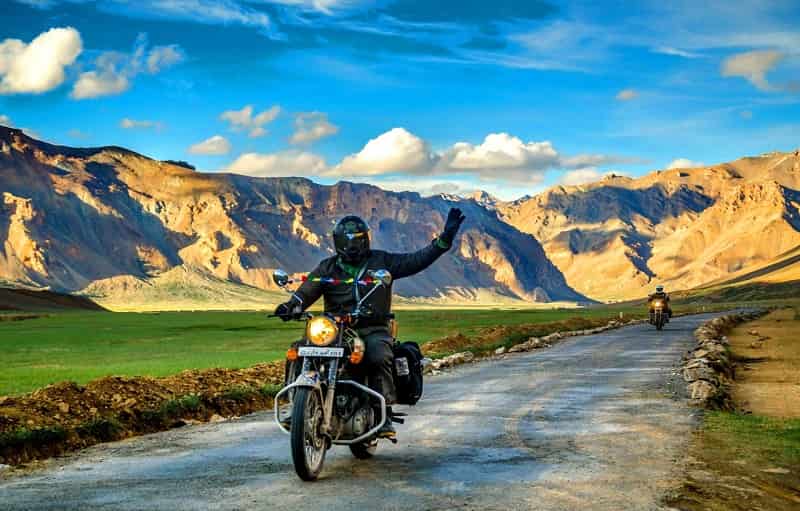
A Leh Ladakh bike trip is a popular adventure for motorcycle enthusiasts and travelers looking to explore the stunning landscapes and unique culture of the Leh and Ladakh regions in northern India. Here are some key points to consider if you’re planning a bike trip to Leh Ladakh:
- Route Planning:
- Decide on your starting point, which is usually Delhi or Manali. The Manali-Leh Highway and the Srinagar-Leh Highway are the two main routes to reach Leh.
- Plan your itinerary carefully, taking into account the distance, altitude, and road conditions. Acclimatization to the high altitude is crucial to avoid altitude sickness.
- Permits:
- Check the permit requirements for the region, as many areas in Ladakh are restricted for tourists. You’ll need an Inner Line Permit (ILP) to visit certain areas like Pangong Lake, Nubra Valley, and Tso Moriri.
- Bike Rental/Preparation:
- If you’re not bringing your own bike, rent one in Delhi or Manali. Ensure it’s in good condition and suited for mountainous terrain.
- Carry essential spare parts, tools, and a first-aid kit. Ladakh is remote, and breakdowns can happen.
- Gear:
- Wear appropriate riding gear, including a full-face helmet, riding jacket, gloves, and sturdy boots.
- Dress in layers as temperatures can vary greatly during the day.
- Acclimatization:
- Leh is situated at a high altitude, so give yourself time to acclimatize before setting out on the road. Rest for at least a day upon arrival.
- Fuel and Supplies:
- Fuel stations are limited, so carry extra fuel in jerry cans.
- Stock up on food and water as you may not find many options in remote areas.
- Accommodation:
- There are various accommodation options in Leh and major tourist spots. However, book in advance during the peak season.
- Health and Safety:
- Stay hydrated and maintain a steady pace to avoid altitude sickness.
- Keep emergency numbers handy.
- Ensure your bike is equipped with good lights and safety features.
- Respect Local Culture:
- Ladakh has a rich culture influenced by Tibetan Buddhism. Respect local customs and traditions, especially when visiting monasteries and religious sites.
- Weather and Timing:
- Ladakh experiences extreme weather conditions, with winters being extremely harsh. The best time for a bike trip is during the summer months, from June to September.
- Backup Plan:
- Be prepared for changes in your itinerary due to unpredictable weather conditions or road closures.
- Environmental Responsibility:
- Leave no trace; practice responsible tourism by not littering and respecting the natural environment.
A Leh Ladakh bike trip can be an exhilarating and life-changing experience. However, it’s essential to be well-prepared and take safety precautions to ensure a smooth and enjoyable journey through this breathtaking region.
Precautions
raveling to Leh Ladakh is an incredible experience, but it comes with unique challenges due to its high altitude and remote location. Taking precautions is essential to ensure your safety and enjoyment during your trip. Here are some key precautions to consider:
- Acclimatization:
- Leh is situated at a high altitude (around 3,500 meters or 11,500 feet), and altitude sickness can be a serious concern. Plan to spend at least a day or two in Leh to acclimatize before heading to higher-altitude areas like Nubra Valley or Pangong Lake.
- Hydration:
- Staying hydrated is crucial at high altitudes. Drink plenty of water throughout the day, but avoid excessive alcohol and caffeine consumption.
- Medications:
- Consider consulting a doctor and carrying medications for altitude sickness, as well as any other necessary medications or first-aid supplies.
- Slow Ascent:
- Avoid rapid ascents to higher altitudes. Ascend gradually and take breaks to allow your body to adjust to the lower oxygen levels.
- Travel Insurance:
- Purchase comprehensive travel insurance that covers medical emergencies and evacuation in case of serious health issues.
- Permits:
- Obtain all necessary permits for restricted areas well in advance to avoid any issues during your trip.
- Weather Awareness:
- Ladakh’s weather can be unpredictable. Check weather forecasts and be prepared for temperature fluctuations, especially if you’re visiting in the shoulder seasons.
- Emergency Contacts:
- Keep a list of emergency contacts, including local authorities, your embassy or consulate, and contacts for your travel insurance provider.
- Communication:
- Mobile network coverage can be limited in remote areas. Consider purchasing a local SIM card with data or a satellite phone for emergencies.
- Emergency Kit:
- Carry a basic emergency kit with items like a flashlight, extra batteries, a whistle, and a multi-tool.
- Food and Water:
- Be cautious about what you eat and drink. Stick to hygienic restaurants and drink bottled or purified water.
- Bike Maintenance:
- If you’re on a motorcycle trip, ensure your bike is in excellent condition before starting the journey. Carry necessary tools, spare parts, and a tire repair kit.
- Environmental Responsibility:
- Respect the environment by not littering and disposing of waste properly. Follow Leave No Trace principles.
- Cultural Sensitivity:
- Respect the local culture and traditions, particularly when visiting monasteries and religious sites. Dress modestly and ask for permission before taking photographs of people.
- Road Conditions:
- Be prepared for challenging road conditions, including unpaved and rugged terrain. Drive carefully and cautiously.
- Group Travel:
- Traveling in a group can be safer and more enjoyable, as you can support each other in case of emergencies.
- Emergency Funds:
- Carry enough cash and credit cards to cover unexpected expenses, as ATMs may be scarce in some areas.
By taking these precautions and being well-prepared, you can have a memorable and safe journey while exploring the stunning landscapes and rich culture of Leh Ladakh.






